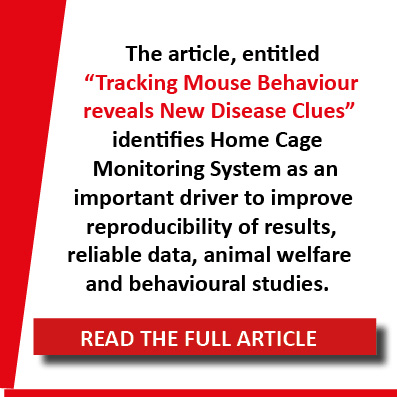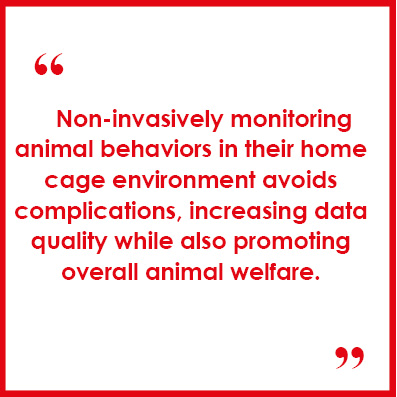
The current version of the Tecniplast website doesn't match your region. Please visit your local website to find information and offerings specific to your country.

The current version of the Tecniplast website doesn't match your region. Please visit your local website to find information and offerings specific to your country.

 Researcher at Helmholtz Zentrum München, Dr.Kenneth Dyar has been interviewed for the latest article by Nature Research, highlighting the benefits of using the DVC® System.
Researcher at Helmholtz Zentrum München, Dr.Kenneth Dyar has been interviewed for the latest article by Nature Research, highlighting the benefits of using the DVC® System.
The article, entitled “Tracking Mouse Behaviour reveals New Disease Clues” identifies Home Cage Monitoring System as an important driver to improve reproducibility of results, reliable data, animal welfare and behavioural studies.
Dear Dr. Dyar, you are one of the interviewed researchers of this interesting article by Nature. Can you summarize its content?
This article was a general overview of how different researchers, including myself, use home cage behavioral data for phenotyping and animal welfare monitoring. The main message is that taking mice out of their home cages for behavioral tests can stress them, altering their behavior and metabolism. Depending on the frequency and time of day these disturbances occur, this can confound data interpretation and lead to irreproducible results. This is a big problem in animal studies at the moment, especially metabolic studies. On the other hand, non-invasively monitoring animal behaviors in their home cage environment avoids this complication, increasing data quality while also promoting overall animal welfare.
 Can you tell our readers results of your research and the importance of the DVC® Technology in reaching the objective?
Can you tell our readers results of your research and the importance of the DVC® Technology in reaching the objective?
We use mouse models of circadian disruption to uncover the underlying molecular mechanisms causing chronic metabolic diseases, like obesity and type 2 diabetes. At the moment this is a huge global challenge, as the number of patients suffering from these diseases continues to rise around the world. Relevant metabolite and hormone levels change according to age, sex, time of day, health status, and relative stress levels. Many of these important signaling molecules also vary after acute changes in locomotor activity and feeding. It is therefore imperative for us to keep track of these overt behaviors in our studies, while also minimizing stress of our animals.
For this we use a combination of tools, including specialized metabolic cages to measure feeding, drinking, and locomotor activity while simultaneously measuring oxygen consumption and energy expenditure (indirect calorimetry). If we only need to monitor locomotor activity, we will use devices like the DVC® tracking system, in which mice can be monitored directly in their home cages in our standard IVC housing setup, or a different setup based on infrared beam-breaks. Our particular choice of tool depends on our experimental needs, including the number of mice we need to measure to have good statistical power, and the duration of the study.
 You are conducting studies on diabetes. Where do you see other interesting applications of the DVC® technology and why?
You are conducting studies on diabetes. Where do you see other interesting applications of the DVC® technology and why?
One of our main objectives is to stop and reverse metabolic diseases, so we also investigate various dietary, pharmacological, or behavioral interventions, including exercise.
Having the option to include a running wheel in the home cage has been useful to monitor how various interventions impact intensity and duration of exercise bouts, in addition to the timing and overall cage activity levels. Mice can be like humans, in that motivation is a key determinant of whether or not they decide to run, so monitoring their wheel running behavior has been useful to screen for “unmotivated” and “motivated” runners, and to investigate potential interactions between genotype and various interventions. This gives us additional insight into how variations in activity levels and timing correspond to molecular adaptations in different tissues, and overall clinical profiles like insulin sensitivity and body composition.
For your research, where would you like to see the DVC® technology in 10 years from now?
Since we often perform dietary interventions, we must carefully monitor daily food intake, in addition to timing of meals. This is extremely laborious, time consuming, and inconvenient (for example, checks must be performed at the same time every day, including weekends). It would be excellent to somehow integrate feeding information into the DVC® system to keep track of when mice are eating and drinking, and how much.
Additionally, an automated process for blocking food access would be extremely useful for paired feeding and time-restricted feeding studies. This again would prevent disturbing the mice unnecessarily and promote more robust and reproducible data. Additional control over the running wheel (for example, timed access and modulating wheel resistance) would further expand its utility for exercise studies.
GIORGIO ROSATI - SENIOR PRODUCT MANAGER DIGILAB, TECNIPLAST S.P.A.